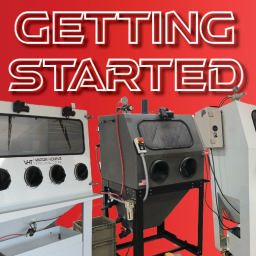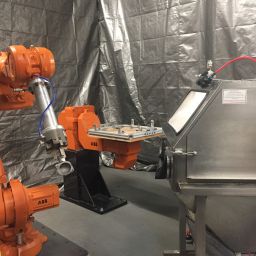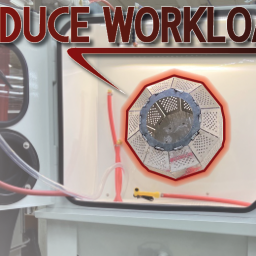Chipped or rusty surfaces are more than just an eyesore. Protective paint can protect industrial or automotive equipment. When this chips, rust can set in and compromise the integrity of your machinery.
Many of our clients here at Vapor Honing Technologies are familiar with the dangers of paint chipping and rust. From automotive mechanics to engine builders, integrity of your equipment is our top priority.
When rust grows on your machinery, it causes multiple safety issues. Rust can eat through gas tanks and cause dangerous leaks.
In an industrial setting, rust can cause important factory equipment to malfunction.
At VHT, we take these issues seriously. We know that the best way to handle equipment malfunction is to prevent it in the first place.
That’s where our top of the line equipment comes in! Our dustless sandblaster options are here to keep your gear in the best working order.
Are you considering a dustless sandblaster for your next project? Then you’re in the right place. Keep reading to find out more about the function and cost of this extraordinary equipment.
How Does Wet Blasting Work?
Wet blasting, or vapor blasting, has become much more popular in recent years. Unlike traditional blasting technologies, wet blasting uses water for a gentler approach to surface abrasion.
In dry abrasive blasting, the abrasive you use comes into direct contact with the surface you’re working on. This abrasive shoots out in compressed air.
After dry blasting, many users apply water directly to the surface. This further cleans the surface, but it doesn’t do much to reduce dust.
Wet blasting is a popular alternative because it reduces the amount of dust created by the blasting process. In wet blasting technology, the blast tank contains a mix of water and abrasive.
The resulting mixture is often called a ‘slurry.’ This slurry is shot at a high speed toward the surface you’re working on. This surface could be cast iron, steel, brass, or other metallic surfaces and even plastics.
The water in a vapor blaster cushions the impact of the abrasive against the surface. This results in less damage to the part you’re working on.
Wet blasting has many advantages over traditional blasting methods. Vapor blasters use less abrasive materials and work more quickly. This saves the user money and makes the stripping process faster.
Another great advantage of this technology is that a vapor blaster also cleans the surface it’s used on. The abrasive strips the paint, but the water cleans the surface below.
Vapor blasters are also an excellent choice if you are working near others. The water traps any hazardous materials or sparks. This ensures the smallest exposure for anyone working around you.
Finally, wet blasting reduces the amount of dust kicked up during the blasting process. We’ll look at this more in the next section.
Is Soda Blasting Better than Vapor Blasting?
Unlike vapor blasting, soda blasting propels abrasive materials using compressed air. This form of blasting uses sodium bicarbonate for the abrasive media.
You might know sodium bicarbonate better for its household uses. This material is the main component in baking soda.
Outside the kitchen, sodium bicarbonate has many industrial uses. Fire extinguishers use this material to combat grease and electrical fires. Sodium bicarbonate is also important for rubber and plastic production.
There are some advantages to soda blasting. First, soda blasting is a cost-efficient process. It might be a good choice for blasting large areas like the side of a cargo ship.
Soda blasting can be an environmentally friendly process. Sodium bicarbonate isn’t toxic for people or animals. It doesn’t leave lasting damage in most settings.
However, soda blasting can harm plants around your work space. Sodium bicarbonate can’t be stored for long periods of time. And it isn’t as effective for blasting as other gritty materials.
Finally, soda blasting can leave a white film on top of the surface you’re working on. You might need to rinse the area with water after soda blasting. This adds an extra step, which means more time and money.
Sand Blasting vs the Dustless Sandblaster
Sand blasting, or dustless sandblasting, has been around for decades. Twenty years ago, sand blasters used silica-containing sand to strip various surfaces.
Today, sand blasters operate with a variety of abrasive materials. Some of the most common abrasive media include: aluminum oxide, glass beads, and garnet.
Early sand blasters used silica-based abrasives. Research has since shown that silica dust can permanently damage our lungs. Modern sand blasting materials do not contain silica.
A sand blaster shoots highly pressurized sand at a surface. Blasting sand on an old surface strips old paint and leaves a smooth finish. Sand blasting is also useful for stripping concrete surfaces. Among the dustless sandblaster community there isn’t much that cant be blasted.
However, dry sand blasting has many disadvantages. This process can create large amounts of dust. Dust inhalation can in turn damage worker’s lungs or even their vision.
Sand blasting equipment needs regular replacement. Hoses are worn out quickly by the sand blasting through them. This process can be very expensive, which is where a dustless sandblaster comes in.
In vapor honing, the water reduces surface heat generated by friction in traditional sand blasting. This increases the lifespan of a dustless blaster, which saves you money in the long run. Not to mention dustless sandblasting is a far better process than any other competing process.
Now let’s take a look at some other advantages of vapor blasting. Then we will consider different pricing options suited to your budget.
Benefits of Aqua Blasting
Aqua blasting offers many advantages over traditional blasting technologies. At VHT, we are passionate about sharing the pros of our expert equipment.
Let’s review some of the main benefits of our vapor honing products:
Abrasive Flexibility
With other blasters, you are limited to certain abrasives like glass or sodium bicarbonate. With a vapor blaster, you have more options for your abrasive media.
In vapor blasting, you can combine different abrasives in your blast tank. This allows you to tailor the abrasive media to any task. From rust and grease to layers of dirt, your vapor blaster can tackle it all. Not to mention you can run abrasives in a wet blast system as small as a human hair in size.
Surface Cleanliness
One key advantage of liquid honing is that this process keeps your surfaces clean. Traditional sand blasting leaves residues in the tiny nooks and crannies on your equipment.
Vapor blasting keeps these crevices clean. This protects your equipment and saves you an extra cleaning step.
Dust Elimination
Dry blasters are infamous for kicking up huge amounts of dust. This can endanger your workers and damage other equipment in your workspace.
A vapor blaster traps abrasive particles in its water stream. Instead of getting kicked up in the form of dust, abrasive materials drip to the ground.
This makes vapor blasting a safer and more environmentally conscious option.
Cooler Temperatures
As we noted in the last section, cooler temperatures keep your vapor equipment working longer than dry blasting technology.
Another huge advantage of the cooler temperatures is that this reduces the chance of damaging your equipment. Conventional dust blasting can warp or bend delicate surfaces.
When you use vapor blasting, the water reduces heat created by friction. This helps keep valuable machinery safe.
Cost of Dry vs Vapor Blasting
Now that we’ve covered some of the advantages of liquid honing, let’s look at the different pricing options available today. First we will consider different costs associated with maintaining these two devices.
In a dry blast cabinet, components can wear out in a short time period. The increased friction caused by the vaporized air takes a huge toll on different parts of a sand blaster.
When you use a sand blaster, you can expect a number of secondary costs. For example, professional sand blasting gloves can run up to $50. These need replacement every several months.
Certain parts of your dry blaster will wear out faster than others. The blast cabinet windows need replacement about once a year. Blast hoses wear out over short time periods and cost an average of $100 to replace.
Blast nozzles also wear out during the blasting process. Ceramic nozzles tend to be the least expensive, but they also wear out quicker than other materials.
Tungsten or boron carbide nozzles are more durable. Of course, these tend to be the most expensive.
When you are preparing for your blasting project, you should consider the durability of your equipment.
For shorter projects, you might go with cheaper equipment. But for long term projects, investing in the right equipment is a must.
Vapor Blasting Costs
Hiring a vapor blasting professional can be an expensive choice. Some workers charge as little as $20/hour, but seasoned professionals can charge up to $200/hour.
For a small project, hiring a professional might be worth it. For example, a corroded engine cylinder head could take only 45 minutes to clean.
Also, certain items fit into a free-standing vapor blaster with a protective shield. But bigger basting projects (e.g., house siding) might require advanced portable equipment.
The national average cost for blasting a house ranges from $3,000 to $7,500 for 1,500 square feet. Gutter cleaning can set you back $200 to $500, and roof cleaning can cost upwards of $2,000.
If your work calls for regular vapor blasting projects, then investing in your own equipment is a smart choice.
At VHT, we offer a range of equipment to fit your budget. Our Vapor Hone 1000 features Boron Carbide blasting gun inserts. This ensures the long lasting performance that’s backed by our lifetime warranty.
When it comes to closed loop options, the VH800P FL Closed Loop’s light industrial design is unparalleled. Foot switches operate the blasting gun for ease of use. A larger control box maximizes functionality.
From smaller models to industrial devices, VHT has you covered. We will be happy to discuss the right pricing options for your unique needs.
Final Considerations
Once you’ve made the exciting step to invest in a vapor blaster, there are a few final considerations to keep in mind.
First, workplace safety is crucial for the long-term functioning of any machine. Vapor blasters should be stored in a safe and stable position. You should make sure there are no toxic substances near or within the machine.
Individuals operating vapor blasters should wear appropriate protective gear. This could include protective overalls, high-quality footwear, and industrial gloves.
Workers may also want to use ear and eye protection during the vapor honing process. They should also inspect for issues like liner wear in the blast nozzle or any air leaks before commencing work.
The air compressor and the air supply hose can wear down after multiple uses. The discharge pressure in your air compressor should be checked before use. Also, any hose fittings or connections need regular inspection.
Finally, it’s important to make sure you are using the right abrasive mixture for your next project. If you’re working on cast iron, you want the right psi for the job.
Here at VHT, we understand that every vapor honing project comes with its own challenges. We are here to help you personalize your equipment to keep you and your clients safe and satisfied.
Take the Next Step Today!
If you’re ready to take the next step on your liquid honing journey, VHT is here to answer all your questions.
Our expert team of vapor honing professionals is committed to helping our customers achieve their goals. We keep track of the evolving market and support our clients to maximize their efficiency and minimize operating costs.
When you’re ready to learn more about our dustless sandblaster options, get in touch!
We look forward to being a part of your professional journey. Here at Vapor Honing Technologies, every client is a priority. And excellence? Well, that’s just who we are.








